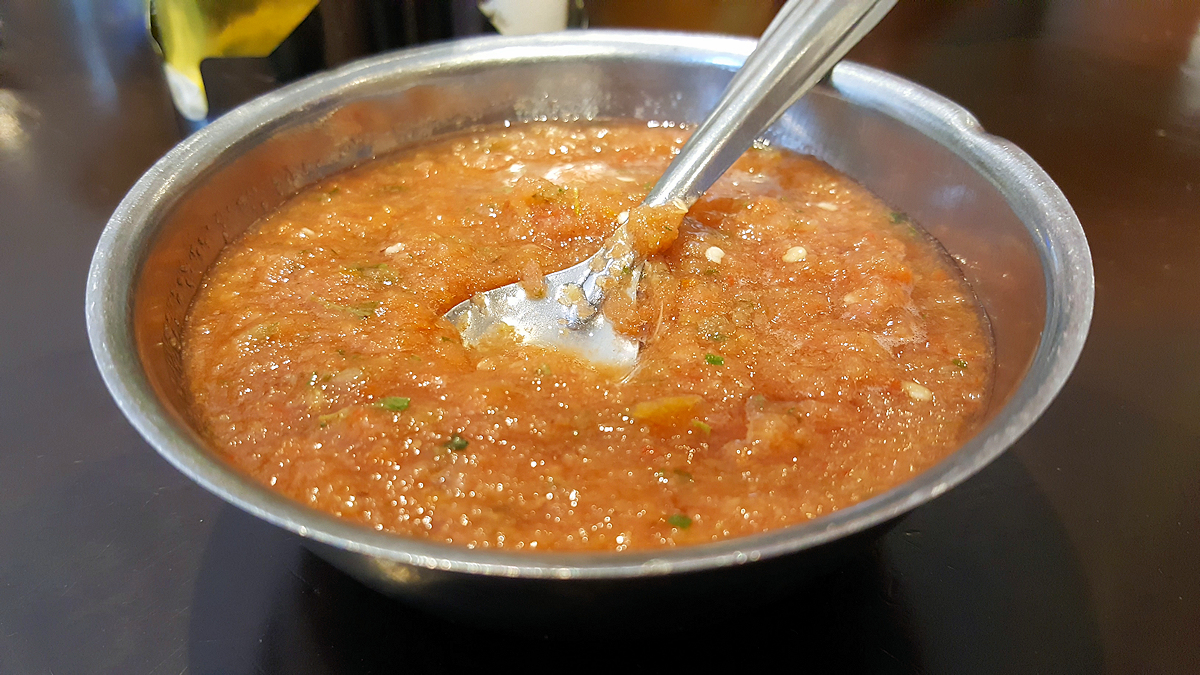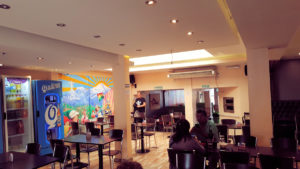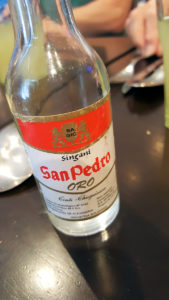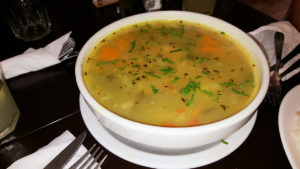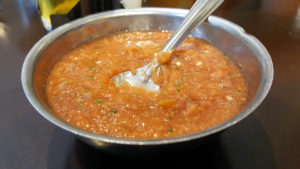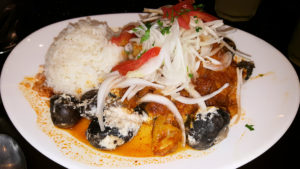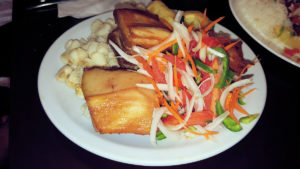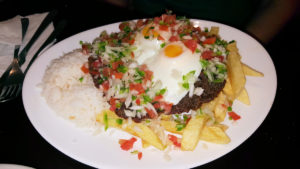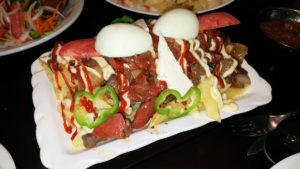So, this video is apparently from the opening of My Bolivia, Av. Rivadavia 7495, Floresta, about a year and a half ago….
I wouldn’t say that in that year and a half they’ve done a great job of maintaining it. It’s not falling apart, and it’s reasonably clean, but it’s showing a lot more wear and tear than I’d expect from such a short time. And there are a couple of things not apparent from the video, like the bathrooms are outside, off of a patio where they also store garbage, and the ladies room has no running water for the sinks. But we didn’t know that when I tossed the place into the weekly ring for the Roving Ravenous Horde’s 43 outing. Five of us arrived, primed to check out a little Bolivian food – something that none of us are overly familiar with. Henry and I have had some experience with it traveling there, but not a lot.
The national liquor of Bolivia is singani, a Moscatel brandy, which one of our number wanted to try, just to get “in the spirit”. And the menu obliged with a conveniently sized 100ml bottle of the stuff. The rest of us went with freshly made lime-ade (not on the menu) that was offered up by our waitress when we were trying to decide between other options.
The menu is pretty light on appetizers, in fact, it really has none – I don’t know if that’s just the way it is with Bolivian cuisine, or just this place. On their cafe menu they listed salteñas and cheese empanadas, I talked about those a little in my writeup a few years back from La Paz. But it turned out to be irrelevant, as they didn’t have either available. The only thing close to an appetizer was the soup from the daily menú, which, like Peruvian restaurants, seemed to be the staple order of most of the folk lunching (not surprising given that it’s 130 pesos, or about $3.50). So, I prevailed on the group to add a bowl of sopa de quinua to our array of dishes. Not bad, but nothing special – a decent chicken soup with a lot of quinua in the bottom (70 pesos, $2).
They also didn’t have any of the four lamb dishes on the menu, nor one of the pork dishes, nor any of the “weekend specials” (okay, it wasn’t a weekend, so that wasn’t a surprise). But it cut down on our choices significantly. While we mused, we spread a delicious fiery salsa llajwa (tomato, rocoto chili, huacatay and quirquiña) on bread – in fact, we pretty much finished this bowl off over the course of the lunch on the various dishes. Bolivian cuisine is not spicy, you add spice to your own tastes.
In short order we had two full main courses and two half main courses on the table for the five of us to split. The picante de pollo, one of those dishes that I’ve never understood the name, as it’s never picante, is a stewed chicken dish with rice and tunta. You might remember I mentioned tunta and chuño in a recent Casa S post – they’re potatoes that have been essentially freeze dried in the mountains and then stored and rehydrated for use. Tunta are the black ones (chuño are white) – one of our number noted that they kind of had the texture and almost the flavor, of chestnuts, though the flavor part might be because they were stewed in peanut sauce. Good flavor, nicely cooked (210 pesos, $5.75).
Chiccharón de cerdo, a half order here. What? That’s a half order? Yeah, really all of these main courses are shareable by two, or more, people. Pechito de cerdo, or “pork breast”, which basically means it’s pork short ribs, cooked until tender, and then lightly browned in a fryer – not to the point of getting crispy and crackly, like chiccharón is in some cultures, in Bolivian food, this is the approach. Served with mote, which is essentially hominy corn. Definitely tasty (200 pesos, $5.50).
A classic Silpancho, which is sort of like a fried, pressed thin patty of seasoned ground beef – kind of like, as one of our group put it, kebbe. Or, really, any sort of beef patty sausage, just pressed out really thin and fried until lightly crisped on both sides. Served over french fries and rice and topped with fried eggs. Another tasty dish, though a bit heavy on the fries (195 pesos, $5.35).
And then, there’s the “garbage plate” or “kitchen sink plate”, that’s ubiquitous in Bolivian restaurants. The pique a lo macho, the “male rivalry” dish. This one has been different each time I’ve seen it, not that I’ve seen that many. But basically, a huge mound of french fries (this is another half portion dish), tossed with cubes of beef, and sliced hot dogs, drenched in mayonnaise and ketchup, and adorned with tomatoes, peppers, and hard boiled eggs. Most of the flavor comes from the fries being soaked in the juices of the two meats, plus, of course, ketchup and mayo. This is “boy am I drunk” food (200 pesos, $5.50, and again, a half portion!).
So, overall, we had a fun outing, and one of our most inexpensive, coming in, with everything, plus a generous tip, at 1400 pesos, or $38, for five people for a lunch we couldn’t finish). We weren’t wowed by any of the food, but then, I don’t know that I’ve ever heard of anyone being wowed by traditional Bolivian food. It was all interesting, it was all good, and I, at least, would happily have lunch their again (and really would like to try some of the lamb or weekend dishes, that sounded more interesting). They could spruce the place up a bit… after only a year and a half open, it shouldn’t like quite so… well used.
